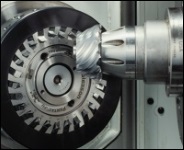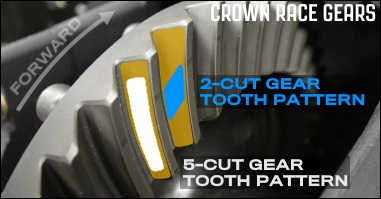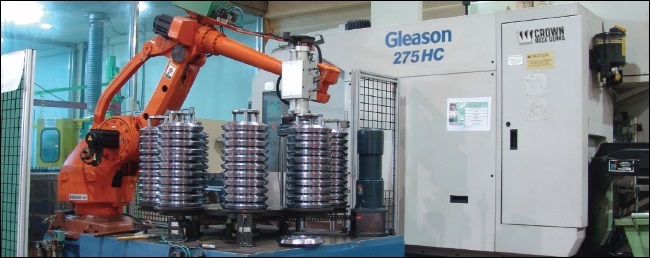- sales@racegears.com
- 720-545-2274
Crown Race Gears / Gear Cutting

Ring and Pinion Gear Cutting

After the forged ring and pinion gear blanks pass inspection, they are ready to be machined into gears. The hypoid gear design used in automotive axles is notoriously complex and requires up to a dozen passes on an advanced CNC machine to complete each ring gear and pinion gear. Intensive and precise adjustments to the machine setup, tooling, and quality control measurements throughout the process is paramount in cutting high precision race gears, and only the most qualified and experienced engineers oversee these complex operations.
The process begins with a quick bore and face clean-up to bring the gear blanks into perfect roundness so that they can be accurately clamped in our CNC machines. The teeth are cut into each ring and pinion gear based on the pre-programmed geometry after which they are case hardened before returning for a final finishing operation.
Gear Geometry
Crown Race Gears relies on data provided by each axle manufacturer for the gear geometry baseline. While most OEM gear manufacturers save costs by using lower quality steel and simplified production processes, we have found that the efficiency, durability, and reliability of OEM geometry simply cannot be improved. Slight adjustment are made to account for the additional final processing performed by Crown Race Gears, as well as for adding strength and removing weight where needed.
OD and ID Cleanup
Once the gear blanks are approved for production, the first step in the gear cutting process is using a CNC lathe to clean up the inside and outside diameters. This process brings each gear blank into perfect roundness so that it can be mounted and centered precisely in our Gleason CNC and gear lapping machines.
5-Cut vs. 2-Cut Gear Cutting
The two currently available methods for cutting automotive ring and pinion gears are called 5-cut face milling and 2-cut face hobbing. The 5-cut process requires numerous offset passes on a 3-axis CNC machine and the 2-cut process is achieved with only two passes on a far more complicated 5-axis CNC machine. While the automotive industry has been reliably using the 5-cut method for many decades, more and more companies are moving to the faster and cheaper 2-cut process.

Each method has it’s own unique geometric characteristics. A 2-cut gear will have ring gear teeth of consistent height with a tapered root width, while 5-cut gear teeth are taller at the outside diameter than they are on the inside diameter, with a constant root width. As a result, on a 2-cut gear set, the pinion gear contacts the ring gear in only the center of the tooth whereas the pinion in a 5-cut gear slides across the length of the tooth surface.
This difference in the gear tooth pattern exposes the biggest flaw of 2-cut geometry and that is that all forces applied to the ring and pinion gears stay in a concentrated area at the center of each tooth. Over time, this area becomes more prone to excessive wear, pitting, and micro-fracturing compared to the 5-cut gear design where loads are constantly spread across the length of each tooth.
While the modern 2-cut gear shaping process might be faster and cheaper, Crown Race Gears continues to use the tried and true 5-cut facing milling process, proven to be reliable in high power, high shock load, and ultra-aggressive racing applications.
Gear Tooth Cutting
The Gleason 275HC Bevel Gear Cutting Machine is the workhorse of the gear shaping process and does all of the roughing, semi-finish, and finish cutting operations on Crown Race Gears. The entire cutting cycle is automated, self-adjusting, and optimized to achieve the tightest tolerances possible. Once the gear blanks are loaded, the corresponding gear cutting code is selected and the machine runs through the numerous cycles needed to create the desired geometry.

Our gear cutting process starts with a rough pass to get the basic shape of the teeth cut into the blanks, followed by a series of secondary cuts to complete the geometry. Once these stages are complete, the gears are case hardened before returning for a final hard finishing process to remove any distortions caused by the heat treatment process.
Large Radius Deburring
After CNC cutting, the outside surfaces of the gear teeth are left with sharp edges where micro-fractures are most likely to start forming. All Crown Race Gears are manually deburred to round out every sharp corner on both ring and pinion gears to eliminate these stress points. REM ISF processing will then finish polish the edges and surfaces for maximum micro-fracture prevention.
Crown Race Gears Shaping
Cutting a ring and pinion gear from a forged gear blank requires highly skilled operators running advanced CNC machines set up within tight tolerances and using precise gear geometry programming. While this process is slower, more involved, and more expensive than that used by most gear manufacturers today, this is what makes Crown Race Gears so efficient, quiet, and long lasting.
